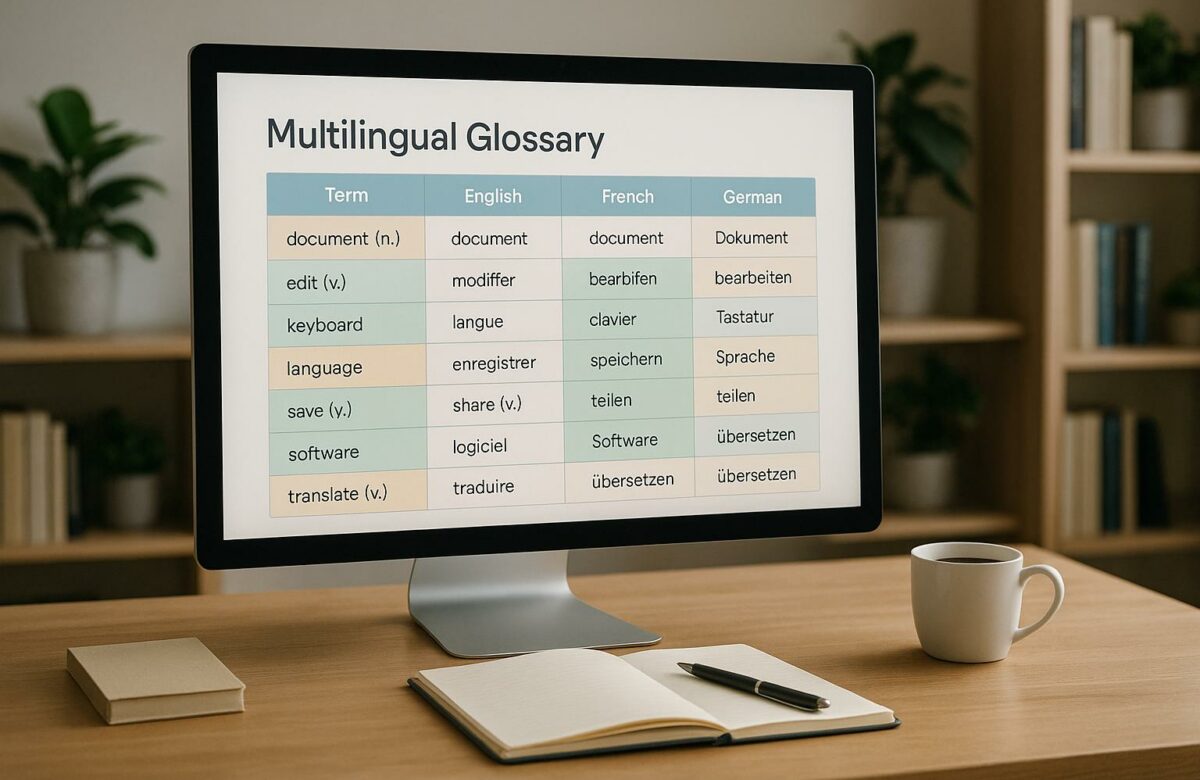How Glossary Tools Improve Multilingual Writing
Struggling with multilingual writing? Glossary tools can help. These tools centralize approved terms and their translations, ensuring consistency, accuracy, and faster workflows. Here’s why they matter:
- Consistency Across Languages: Glossary tools standardize terminology, like product names or medical terms, to avoid errors.
- Better Translations: They provide definitions, context, and industry-specific terms for precise translations.
- Save Time and Money: Instant access to terms reduces revisions and speeds up projects.
- Key Features: Term databases, live suggestions, and specialized vocabularies tailored to industries like medical, legal, and technical writing.
For example, tools like BeLikeNative support 80+ languages, offer real-time term suggestions, and integrate with writing software. These features help businesses maintain brand voice globally and simplify complex multilingual content creation.
Step-by-Step Guide to Creating a Multilingual Glossary!
Main Advantages of Using Glossary Tools
Glossary tools improve translation quality, simplify workflows, and help reduce costs. Let’s dive into how they achieve this.
Keeping Terms Consistent Across Languages
For global organizations, maintaining consistent terminology across multiple languages can be a tough challenge. Glossary tools solve this by providing a centralized database of approved terms and their translations. This ensures that essential terminology – like product names, technical details, or brand messaging – stays consistent across all content.
Take medical documentation, for example. These tools help prevent dangerous errors, like mistranslating drug names or procedural terms. In legal documents, they ensure compliance and clear interpretation by standardizing language.
BeLikeNative takes this a step further with real-time suggestions in over 80 languages. This feature allows writers and translators to quickly verify and apply approved terms without losing the original meaning or context.
Making Translations More Accurate
Accurate translations depend on understanding context and choosing the right terms. Glossary tools enhance accuracy by offering clear definitions and usage guidelines for specialized terms. They ensure translators maintain clarity, use industry-specific vocabulary correctly, and adapt language to regional nuances while staying true to the brand. Here’s a closer look:
| Aspect | Translation Impact |
|---|---|
| Context Clarity | Provides detailed examples and explanations |
| Term Validation | Ensures correct use of specialized vocabulary |
| Cultural Adaptation | Supports region-specific terminology |
| Brand Consistency | Keeps messaging aligned across different markets |
With instant access to approved terms, translators can deliver precise, polished translations with fewer revisions.
Reducing Time Spent on Corrections
Glossary tools save time by giving translators immediate access to approved terminology. This eliminates the need for lengthy research or repeated back-and-forth discussions within teams. As a result, organizations can:
- Finish projects more quickly
- Use resources more effectively
- Cut costs by reducing revision cycles
- Deliver consistent quality, even on large-scale projects
Key Features of Glossary Tools
Glossary tools simplify the process of creating multilingual content by focusing on features that maintain both quality and consistency.
Term Database Management
At the heart of every glossary tool is a centralized term repository. This database organizes terms by language, subject, project, or client, making it easy to manage and retrieve information. It also tracks changes through approval workflows, ensuring updates are quick and controlled.
This centralized system powers live suggestions, which make content creation even smoother.
Live Term Suggestions
With the structured database in place, live term suggestions provide real-time assistance for writers. As text is being written, the system actively detects glossary terms and offers relevant suggestions.
| Function | Benefit |
|---|---|
| Pattern Recognition | Detects terms in different grammatical forms |
| Context Analysis | Recommends translations based on the specific context |
| Immediate Consistency Checks | Flags inconsistencies before they appear |
| Cross-Reference | Ensures terminology is aligned across multiple documents |
BeLikeNative supports instant term suggestions in over 80 languages, offering a seamless experience for global teams.
Industry-Specific Term Sets
Glossary tools often include specialized vocabulary tailored to specific fields, ensuring precision and clarity in professional communication:
- Medical Documentation: Standardized terms for procedures, medications, and equipment help maintain accurate and reliable patient records.
- Legal Documents: Jurisdiction-specific terminology guarantees compliance and clarity in legal contexts.
- Technical Documentation: Consistent technical vocabulary ensures uniformity across product manuals and guides.
These tailored term sets are essential for achieving clear, consistent communication across specialized industries.
sbb-itb-32359dc
Setting Up Your Glossary Tools
Getting your glossary tools up and running is the first step to ensuring your multilingual content stays accurate and consistent. A well-organized glossary is key to maintaining clarity across different languages.
Creating Your First Glossary
Begin by laying a solid foundation for your terminology database. Start by identifying and organizing the terms that are critical to your multilingual content. Here’s a quick breakdown:
| Step | Action | Purpose |
|---|---|---|
| Term Collection | Gather industry-specific terms and common phrases | Build a reliable term base |
| Definition Creation | Write clear, context-specific explanations | Ensure accurate understanding |
| Language Mapping | Connect terms across all target languages | Maintain consistency |
| Metadata Addition | Add usage notes and context examples | Help translators understand nuances |
Using clear definitions and examples for complex or specialized terms will make your glossary easier to use. Once everything is in place, link your glossary with your writing tools to keep things running smoothly.
Connecting with Writing Software
To make the most of your glossary, integrate it with the writing tools your team uses. Here’s how you can do it:
- Set Up Version Control: Keep track of terminology updates so everyone works with the latest version.
- Configure Access Permissions: Assign role-based access levels to safeguard your data while allowing collaboration.
- Enable Cross-Platform Sync: Ensure your glossary is accessible across all platforms your team relies on.
For added efficiency, consider using tools like BeLikeNative to manage your terms effortlessly.
Using BeLikeNative for Term Management

BeLikeNative simplifies managing terminology across more than 80 languages through its user-friendly Chrome extension. The tool’s clipboard integration makes it easy to verify terms as you write, ensuring consistency.
Here’s how to get started with BeLikeNative:
- Set your preferred languages in the extension settings.
- Create custom shortcuts for quick access to terms.
- Adjust tone and style based on your content type.
- Organize terms by industry, audience, region, or content type.
The Native plan supports checks of up to 4,000 characters at a time, making it a powerful tool for validating terminology across large pieces of content.
Conclusion: Impact of Glossary Tools on Writing
Glossary tools aren’t just helpful – they’re game-changers for improving writing quality, especially in multilingual contexts. By addressing common hurdles in global content creation, these tools have become essential for ensuring clarity and consistency.
Consistency and Brand Voice Made Simple
A well-maintained glossary acts as a safeguard for technical terms, product names, and brand messaging. It ensures that your communication stays uniform across all languages while keeping your brand identity intact in every market you serve.
Efficiency That You Can Measure
Glossary management systems streamline workflows and deliver clear benefits:
| Benefit Area | How It Helps |
|---|---|
| Time Management | Cuts down on repetitive translation tasks and minimizes the need for revisions. |
| Quality Control | Ensures accurate and consistent use of terminology in all your content. |
| Cost Savings | Reduces duplicate translation efforts and the expense of fixing errors. |
| Compliance | Guarantees uniformity in technical and legal terminology. |
Take BeLikeNative as an example. With support for over 80 languages, it offers clipboard integration and customizable features, making it easy for writers to maintain consistency across platforms. Tools like this highlight how glossary systems simplify terminology management and enhance productivity.
Precision for Specialized Industries
Glossary tools shine brightest in fields like technical writing, legal documentation, and medical content, where exact terminology is non-negotiable. They shift the focus from fixing errors after the fact to ensuring accuracy from the start.
By turning terminology management into a proactive process, these tools help global organizations transform multilingual content into a competitive edge.
FAQs
How do glossary tools help maintain a consistent brand voice across multiple languages?
Glossary tools are essential for keeping your brand voice consistent across different languages. By standardizing key terms and phrases, they help avoid misunderstandings and ensure that your brand’s tone, style, and messaging stay aligned, no matter the language.
These tools work by offering precise definitions and translations for important terminology. This reduces errors, promotes clarity, and ensures your communication feels reliable and professional. Ultimately, maintaining this consistency strengthens your brand identity and fosters trust with audiences worldwide.
How can I integrate glossary tools into my writing software effectively?
To connect a glossary tool with your writing software, begin by selecting one that aligns well with your platform. Once chosen, create your glossary by entering important terms along with their definitions or translations. Configure the tool to offer real-time suggestions and monitor for consistency while you write. It’s also important to introduce your team to the tool’s features so they can use it effectively. Regularly update the glossary with new terms to keep your content accurate and consistent. This approach simplifies multilingual writing and ensures consistent terminology throughout your work.
How can glossary tools be customized for industries like medical or legal writing?
Glossary tools can be fine-tuned to suit the specific demands of fields like medical or legal writing by including specialized terms and definitions. For example, in medical writing, this might mean adding terminology related to pharmaceuticals, medical devices, or even advancements like AI in healthcare. In legal writing, such tools can feature precise legal jargon, compliance-related terms, and language tailored to specific jurisdictions.
Customizing glossaries this way helps professionals maintain consistency, eliminate ambiguity, and align with regulatory requirements, ensuring multilingual content is both precise and dependable.



13 Comments
chinese enclomiphene pills for sale in the usa
August 17, 20258:06 am
enclomiphene from canadian druggists
buying enclomiphene generic release date
kamagra et interactions médicamenteuses avec la vytorine
August 17, 20259:25 am
acheter kamagra en ligne canada
medicament kamagra pharmacie a paris
discount androxal buy dublin
August 17, 202510:09 am
cheap androxal buy online uk
purchase androxal buy uk no prescription
buying dutasteride generic release date
August 17, 202512:56 pm
ordering dutasteride purchase online safely
discount dutasteride generic online usa
get flexeril cyclobenzaprine generic canada
August 17, 20251:12 pm
ordering flexeril cyclobenzaprine canada drugs
cheapest buy flexeril cyclobenzaprine buy san francisco
buy cheap gabapentin without prescriptions canada
August 17, 20252:19 pm
purchase gabapentin lowest price
cheap gabapentin without prescription overnight delivery
online order fildena generic in canada
August 17, 20253:46 pm
US pharmacies for fildena without rx
buy cheap fildena generic uk next day delivery
Where to buy generic staxyn online without a perscription
August 18, 20252:42 am
get staxyn generic dosage
get staxyn buy virginia
itraconazole with consult
August 18, 20252:53 am
Buying itraconazole without a perscription
buy itraconazole generic online mastercard
cheapest buy avodart cost effectiveness
August 18, 20253:58 am
get avodart usa buying
buy avodart cheap info
canadian pharmacies without prescriptions rifaximin
August 18, 20255:50 am
buy rifaximin generic drug
buying rifaximin purchase online from canada
purchase xifaxan buy dublin
August 18, 20256:00 am
xifaxan canadian
Buying xifaxan online without a perscription
nákup kamagra se slevou
August 18, 20258:38 am
acheter kamagra en ligne
cod kamagra bez lékařského předpisu
Comments are closed.